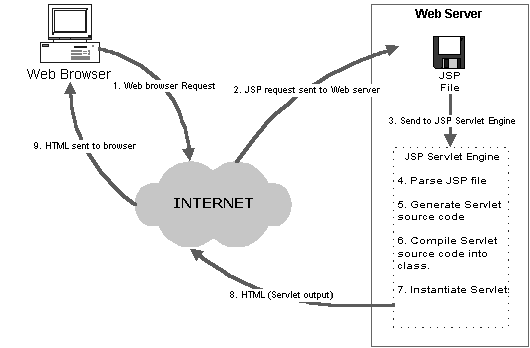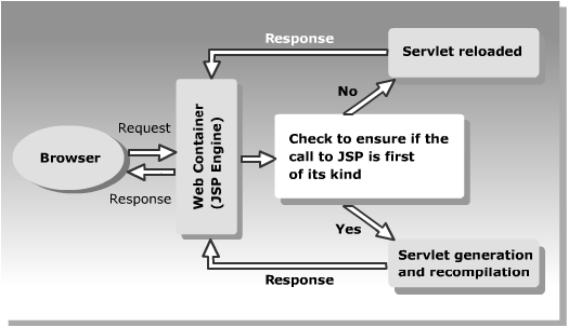JSP Application Architecture
JSPs are built on top of Oracle’s Servlet technology. JSPs are essentially an HTML page with special JSP tags embedded. These JSP tags can contain Java code. The JSP file extension is .jsp rather than .htm or .html. The JSP engine parses the .jsp and creates a Java Servlet source file. It then compiles the source file into a class file; this is done the first time and that is why the JSP is probably slower the first time it is accessed. Any time after this the special compiled Servlet is executed and is therefore returns faster.

Figure 1: JSP Architecture
Steps required for a JSP request:
Step 1. The user goes to a web site made using JSP. The user goes to a JSP page (ending with .jsp). The web browser makes the request via the Internet.
Step 2. The JSP request gets sent to the Web server.
Step 3. The Web server recognizes that the file required is special (.jsp), therefore passes the JSP file to the JSP Servlet Engine.
Step 4. If the JSP file has been called the first time, the JSP file is parsed, otherwise go to step 7.
Step 5. The next step is to generate a special Servlet from the JSP file. The entire HTML required is converted to println statements.
Step 6. The Servlet source code is compiled into a class file.
Step 7. The Servlet is instantiated, calling the init and service methods.
Step 8. HTML from the Servlet output is sent via the Internet.
Step 9. HTML results are displayed on the user’s web browser.
JSP Life Cycle
The pictorial view of the JSP life cycle phase is as below:

Figure 2: JSP life cycle phases
There are 7 phases in JSP life cycle:
1. Page Translation:- The JSP page is parsed and a Java file containing the corresponding Servlet is created.
2. Page Compilation:- The Java file is compiled.
3. Load class:- The compiled Servlet class is loaded.
4. Create instance:- An instance of the Servlet is created. 0
5. Call jspInit():- This method is called before any other method to allow initialization. It is called only once.
6. Call _jspService():- This method is called for each request.
7. Call jspDestroy():- This method is called when the Servlet container decides to take the Servlet out of service. It is called only once.